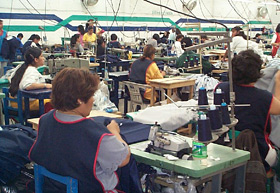 |
 |
 |
 Business News | January 2006 Business News | January 2006  
Maquiladora Industry is Resilient, Expert Says
 iane Lindquist - Union-Tribune iane Lindquist - Union-Tribune


| | Tijuana, with 576 plants, continues to have the largest number of factories. And Ciudad Juarez, with 228,900 workers, has the biggest employment. |
Mexico's maquiladoras last year regained the number of operators that left the country in the early 2000s, surpassed the number of workers employed before the crisis and switched to activities with more value and stability, an industry expert said yesterday.

The maquiladora industry is not going to disappear. It's going to re-invent itself, said John H. Christman, director of maquiladora econometric service for Global Insight. We're looking at a maquiladora industry that is more sophisticated, more developed and more high-tech.

Global Insight, a U.S. economic forecasting company, presented an outlook yesterday at the Doubletree Hotel in Mission Valley for the mainly foreign-operated maquiladora manufacturing industry in Mexico that provides many consumer goods purchased in the United States.

Christman, who has observed the industry from Mexico for 40 years, said maquiladoras have had slow but steady growth since the crisis of 2001-03 with the exception of certain sectors. And we can pretty much kiss them bye-bye.

The exodus of textile and apparel operations, which began during the industry downturn, continued during 2005, he noted. Employment in the sector dropped 24.7 percent.

That's in contrast to gains of 15.1 percent in factories making automotive parts, equipment and accessories and 11.1 percent in plants producing electronics, electrical materials and accessories the two strongest maquiladora growth sectors.

By the end of last year, the number of maquiladoras in Mexico stood at 2,890 with an employment of 1,207,300 workers. The value of the factories' production totaled $112.7 billion.

Direct foreign investment in the industry is expected to have reached $2.5 billion to $2.7 billion in 2005, he said, and should top $3 billion this year.

Tijuana, with 576 plants, continues to have the largest number of factories. And Ciudad Juarez, with 228,900 workers, has the biggest employment.

Christman predicted that by the end of the decade maquiladora employment in Mexico will have increased 7.3 percent from 2003 to 1.38 million workers. He said the number of plants will reach 3,140 with nearly two-thirds located in border cities and four-fifths in the northern border states.

Sara Johnson, the managing director of Global Insight's global macroeconomics operations, warned that the cooling housing market in the United States and resulting retraction in some areas of consumer spending is likely to cause a slowing among Mexican plants producing furniture and household supplies.

Christman also identified some risk areas within Mexico that are likely to affect the industry. Among them are:

Tensions in U.S.-Mexico political relations over migration policy, the North American Free Trade Agreement's agriculture provisions, and trucking.

The failure of Mexico's government to address the country's shrinking global competitiveness.

Mexico's gradually diminishing proven oil, gas and electrical power resources.

Increasing violence that seems beyond the control of authorities.

The Mexican elections for president, for the congress and five governorships could present a risk this year, Christman warned.

None of the three major presidential candidates have addressed the industry, he said, even though maquiladora growth is four times higher than other manufacturing growth in Mexico, it receives a third of all direct foreign investment in the country, and it accounts for 56 percent of all Mexico's manufacturing exports.

The industry is among the mostly highly regulated sectors with a profusion of bureaucratic rules that are hurting its competitiveness, he noted.

I don't know if (the candidates) have a posture, and what it was yesterday might be different than it is today, Christman said. Who knows what they're going to do if they get into office.

Diane Lindquist: (619) 293-1812; diane.lindquist@uniontrib.com | 
 | |
 |



